A Proposal to End Gender Discrimination at Walmart Company
VerifiedAdded on 2022/09/21
|6
|1202
|56
Report
AI Summary
This report presents a proposal aimed at addressing the issue of gender discrimination within Walmart Inc., the world's largest retail company. The proposal begins by outlining the scope of the problem, referencing the numerous lawsuits filed against the company concerning unequal pay and denial of management opportunities for female employees. The research methodology involves both qualitative and quantitative approaches, including surveys and analysis of secondary sources like past lawsuits. The discussion section highlights the history of gender discrimination at Walmart, including the landmark case of Betty Dukes and the subsequent legal battles. The proposal suggests potential solutions, such as enforcing employment laws, promoting gender balance, and encouraging women to report grievances. The report also details the steps, timeline, and associated costs for conducting the study. The conclusion emphasizes the existence of gender discrimination at Walmart and other retail companies, advocating for government intervention, employer sensitization, and empowering female employees to voice their concerns. The report references several academic sources to support its findings and recommendations.
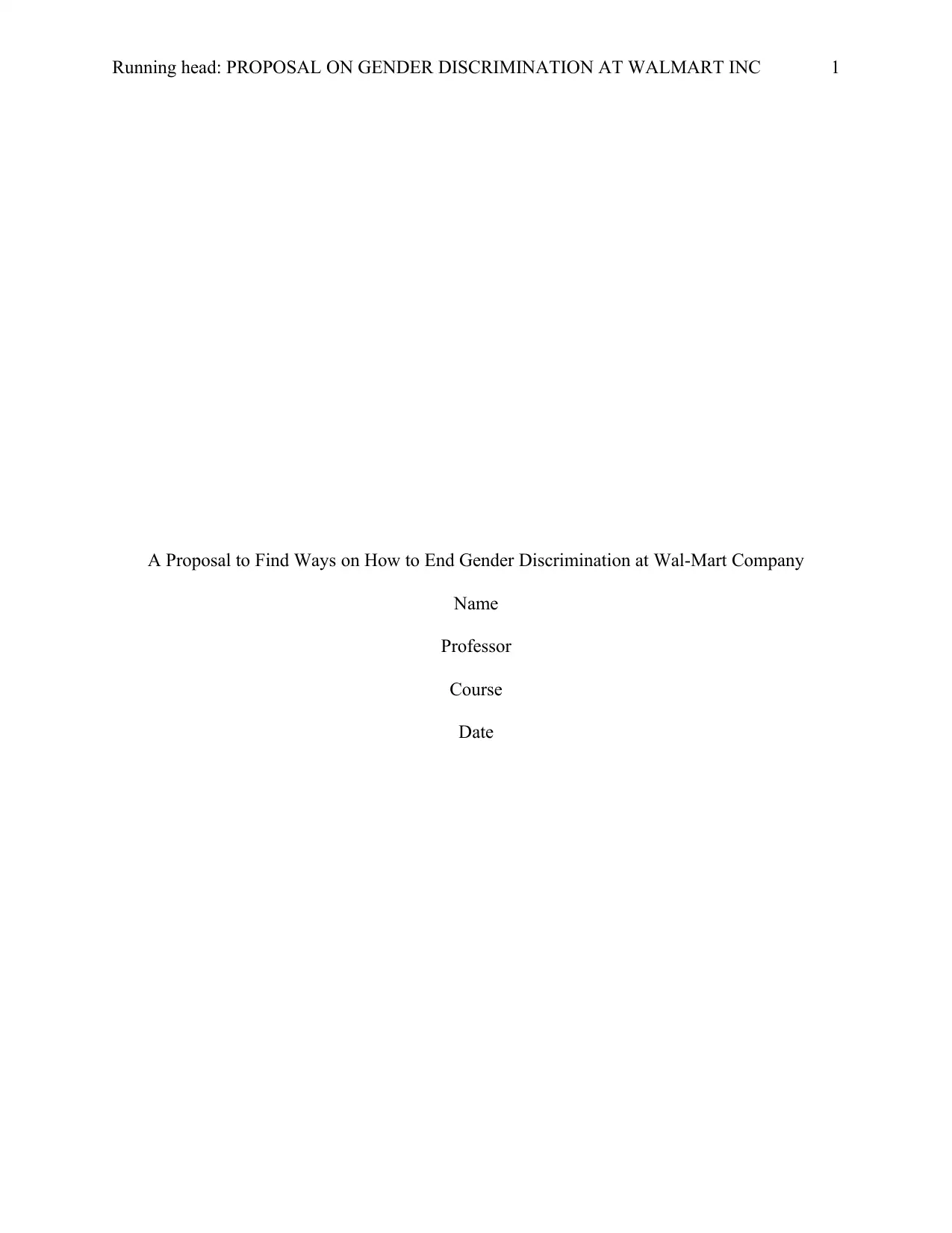
Running head: PROPOSAL ON GENDER DISCRIMINATION AT WALMART INC 1
A Proposal to Find Ways on How to End Gender Discrimination at Wal-Mart Company
Name
Professor
Course
Date
A Proposal to Find Ways on How to End Gender Discrimination at Wal-Mart Company
Name
Professor
Course
Date
Paraphrase This Document
Need a fresh take? Get an instant paraphrase of this document with our AI Paraphraser
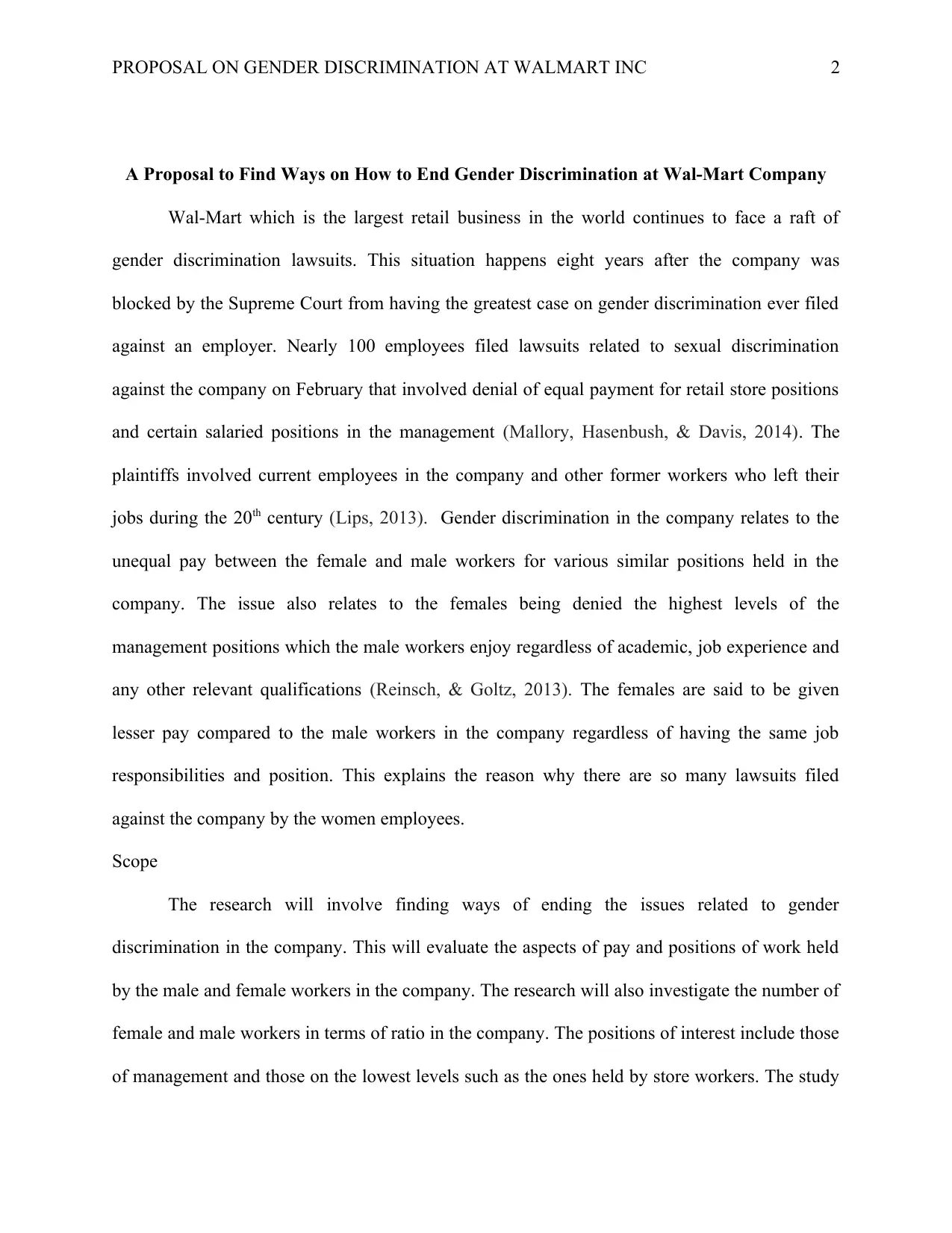
PROPOSAL ON GENDER DISCRIMINATION AT WALMART INC 2
A Proposal to Find Ways on How to End Gender Discrimination at Wal-Mart Company
Wal-Mart which is the largest retail business in the world continues to face a raft of
gender discrimination lawsuits. This situation happens eight years after the company was
blocked by the Supreme Court from having the greatest case on gender discrimination ever filed
against an employer. Nearly 100 employees filed lawsuits related to sexual discrimination
against the company on February that involved denial of equal payment for retail store positions
and certain salaried positions in the management (Mallory, Hasenbush, & Davis, 2014). The
plaintiffs involved current employees in the company and other former workers who left their
jobs during the 20th century (Lips, 2013). Gender discrimination in the company relates to the
unequal pay between the female and male workers for various similar positions held in the
company. The issue also relates to the females being denied the highest levels of the
management positions which the male workers enjoy regardless of academic, job experience and
any other relevant qualifications (Reinsch, & Goltz, 2013). The females are said to be given
lesser pay compared to the male workers in the company regardless of having the same job
responsibilities and position. This explains the reason why there are so many lawsuits filed
against the company by the women employees.
Scope
The research will involve finding ways of ending the issues related to gender
discrimination in the company. This will evaluate the aspects of pay and positions of work held
by the male and female workers in the company. The research will also investigate the number of
female and male workers in terms of ratio in the company. The positions of interest include those
of management and those on the lowest levels such as the ones held by store workers. The study
A Proposal to Find Ways on How to End Gender Discrimination at Wal-Mart Company
Wal-Mart which is the largest retail business in the world continues to face a raft of
gender discrimination lawsuits. This situation happens eight years after the company was
blocked by the Supreme Court from having the greatest case on gender discrimination ever filed
against an employer. Nearly 100 employees filed lawsuits related to sexual discrimination
against the company on February that involved denial of equal payment for retail store positions
and certain salaried positions in the management (Mallory, Hasenbush, & Davis, 2014). The
plaintiffs involved current employees in the company and other former workers who left their
jobs during the 20th century (Lips, 2013). Gender discrimination in the company relates to the
unequal pay between the female and male workers for various similar positions held in the
company. The issue also relates to the females being denied the highest levels of the
management positions which the male workers enjoy regardless of academic, job experience and
any other relevant qualifications (Reinsch, & Goltz, 2013). The females are said to be given
lesser pay compared to the male workers in the company regardless of having the same job
responsibilities and position. This explains the reason why there are so many lawsuits filed
against the company by the women employees.
Scope
The research will involve finding ways of ending the issues related to gender
discrimination in the company. This will evaluate the aspects of pay and positions of work held
by the male and female workers in the company. The research will also investigate the number of
female and male workers in terms of ratio in the company. The positions of interest include those
of management and those on the lowest levels such as the ones held by store workers. The study
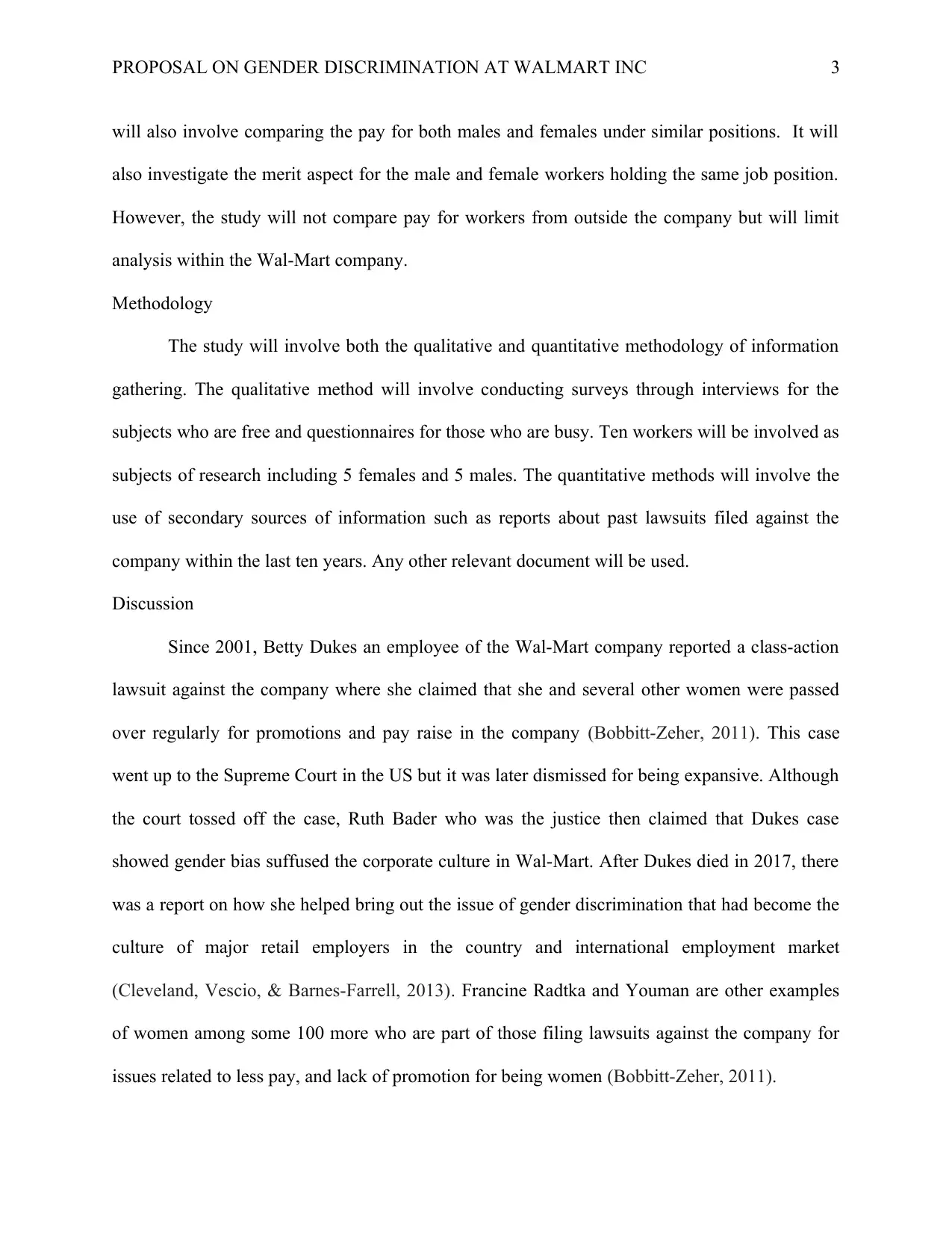
PROPOSAL ON GENDER DISCRIMINATION AT WALMART INC 3
will also involve comparing the pay for both males and females under similar positions. It will
also investigate the merit aspect for the male and female workers holding the same job position.
However, the study will not compare pay for workers from outside the company but will limit
analysis within the Wal-Mart company.
Methodology
The study will involve both the qualitative and quantitative methodology of information
gathering. The qualitative method will involve conducting surveys through interviews for the
subjects who are free and questionnaires for those who are busy. Ten workers will be involved as
subjects of research including 5 females and 5 males. The quantitative methods will involve the
use of secondary sources of information such as reports about past lawsuits filed against the
company within the last ten years. Any other relevant document will be used.
Discussion
Since 2001, Betty Dukes an employee of the Wal-Mart company reported a class-action
lawsuit against the company where she claimed that she and several other women were passed
over regularly for promotions and pay raise in the company (Bobbitt-Zeher, 2011). This case
went up to the Supreme Court in the US but it was later dismissed for being expansive. Although
the court tossed off the case, Ruth Bader who was the justice then claimed that Dukes case
showed gender bias suffused the corporate culture in Wal-Mart. After Dukes died in 2017, there
was a report on how she helped bring out the issue of gender discrimination that had become the
culture of major retail employers in the country and international employment market
(Cleveland, Vescio, & Barnes-Farrell, 2013). Francine Radtka and Youman are other examples
of women among some 100 more who are part of those filing lawsuits against the company for
issues related to less pay, and lack of promotion for being women (Bobbitt-Zeher, 2011).
will also involve comparing the pay for both males and females under similar positions. It will
also investigate the merit aspect for the male and female workers holding the same job position.
However, the study will not compare pay for workers from outside the company but will limit
analysis within the Wal-Mart company.
Methodology
The study will involve both the qualitative and quantitative methodology of information
gathering. The qualitative method will involve conducting surveys through interviews for the
subjects who are free and questionnaires for those who are busy. Ten workers will be involved as
subjects of research including 5 females and 5 males. The quantitative methods will involve the
use of secondary sources of information such as reports about past lawsuits filed against the
company within the last ten years. Any other relevant document will be used.
Discussion
Since 2001, Betty Dukes an employee of the Wal-Mart company reported a class-action
lawsuit against the company where she claimed that she and several other women were passed
over regularly for promotions and pay raise in the company (Bobbitt-Zeher, 2011). This case
went up to the Supreme Court in the US but it was later dismissed for being expansive. Although
the court tossed off the case, Ruth Bader who was the justice then claimed that Dukes case
showed gender bias suffused the corporate culture in Wal-Mart. After Dukes died in 2017, there
was a report on how she helped bring out the issue of gender discrimination that had become the
culture of major retail employers in the country and international employment market
(Cleveland, Vescio, & Barnes-Farrell, 2013). Francine Radtka and Youman are other examples
of women among some 100 more who are part of those filing lawsuits against the company for
issues related to less pay, and lack of promotion for being women (Bobbitt-Zeher, 2011).
⊘ This is a preview!⊘
Do you want full access?
Subscribe today to unlock all pages.

Trusted by 1+ million students worldwide
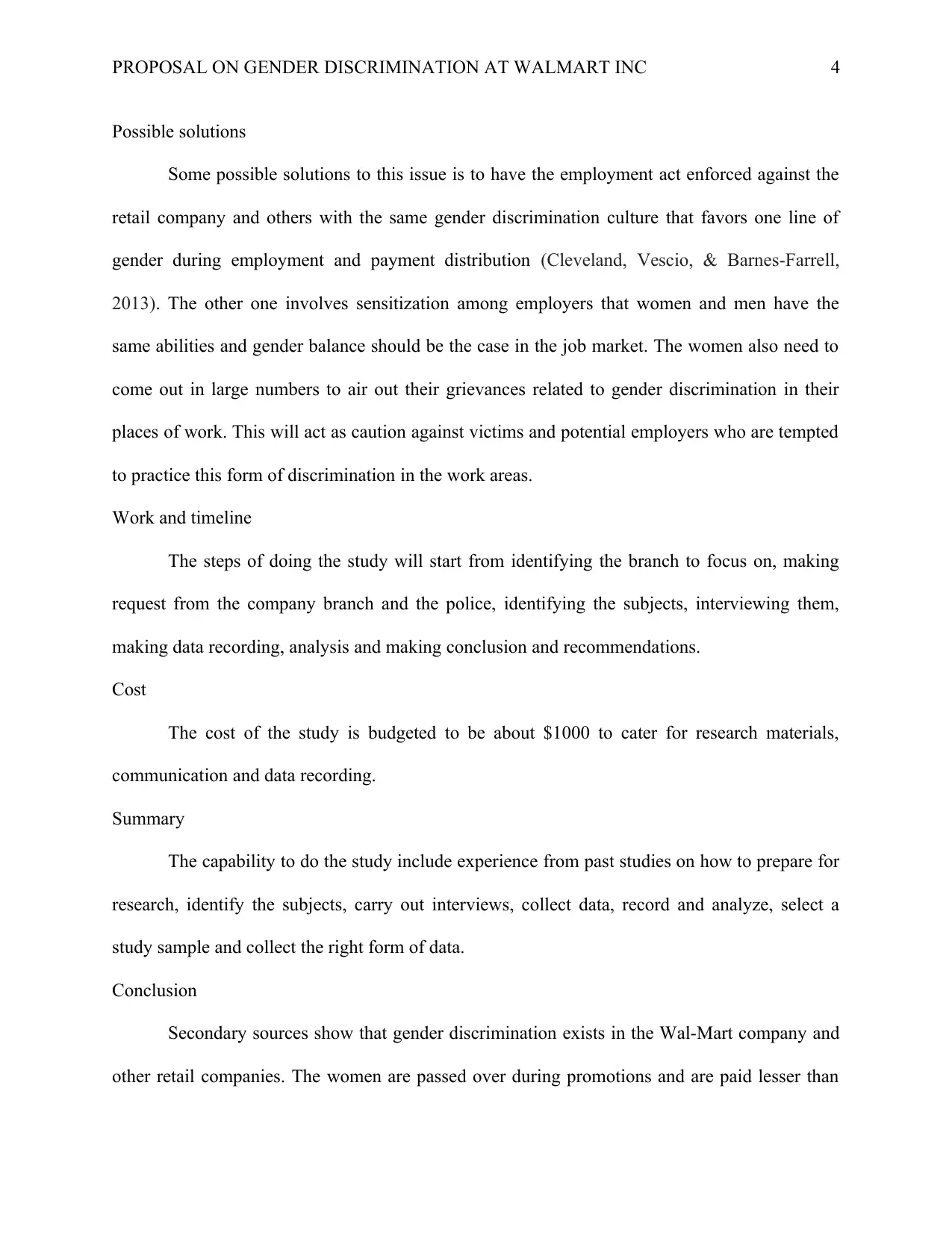
PROPOSAL ON GENDER DISCRIMINATION AT WALMART INC 4
Possible solutions
Some possible solutions to this issue is to have the employment act enforced against the
retail company and others with the same gender discrimination culture that favors one line of
gender during employment and payment distribution (Cleveland, Vescio, & Barnes-Farrell,
2013). The other one involves sensitization among employers that women and men have the
same abilities and gender balance should be the case in the job market. The women also need to
come out in large numbers to air out their grievances related to gender discrimination in their
places of work. This will act as caution against victims and potential employers who are tempted
to practice this form of discrimination in the work areas.
Work and timeline
The steps of doing the study will start from identifying the branch to focus on, making
request from the company branch and the police, identifying the subjects, interviewing them,
making data recording, analysis and making conclusion and recommendations.
Cost
The cost of the study is budgeted to be about $1000 to cater for research materials,
communication and data recording.
Summary
The capability to do the study include experience from past studies on how to prepare for
research, identify the subjects, carry out interviews, collect data, record and analyze, select a
study sample and collect the right form of data.
Conclusion
Secondary sources show that gender discrimination exists in the Wal-Mart company and
other retail companies. The women are passed over during promotions and are paid lesser than
Possible solutions
Some possible solutions to this issue is to have the employment act enforced against the
retail company and others with the same gender discrimination culture that favors one line of
gender during employment and payment distribution (Cleveland, Vescio, & Barnes-Farrell,
2013). The other one involves sensitization among employers that women and men have the
same abilities and gender balance should be the case in the job market. The women also need to
come out in large numbers to air out their grievances related to gender discrimination in their
places of work. This will act as caution against victims and potential employers who are tempted
to practice this form of discrimination in the work areas.
Work and timeline
The steps of doing the study will start from identifying the branch to focus on, making
request from the company branch and the police, identifying the subjects, interviewing them,
making data recording, analysis and making conclusion and recommendations.
Cost
The cost of the study is budgeted to be about $1000 to cater for research materials,
communication and data recording.
Summary
The capability to do the study include experience from past studies on how to prepare for
research, identify the subjects, carry out interviews, collect data, record and analyze, select a
study sample and collect the right form of data.
Conclusion
Secondary sources show that gender discrimination exists in the Wal-Mart company and
other retail companies. The women are passed over during promotions and are paid lesser than
Paraphrase This Document
Need a fresh take? Get an instant paraphrase of this document with our AI Paraphraser
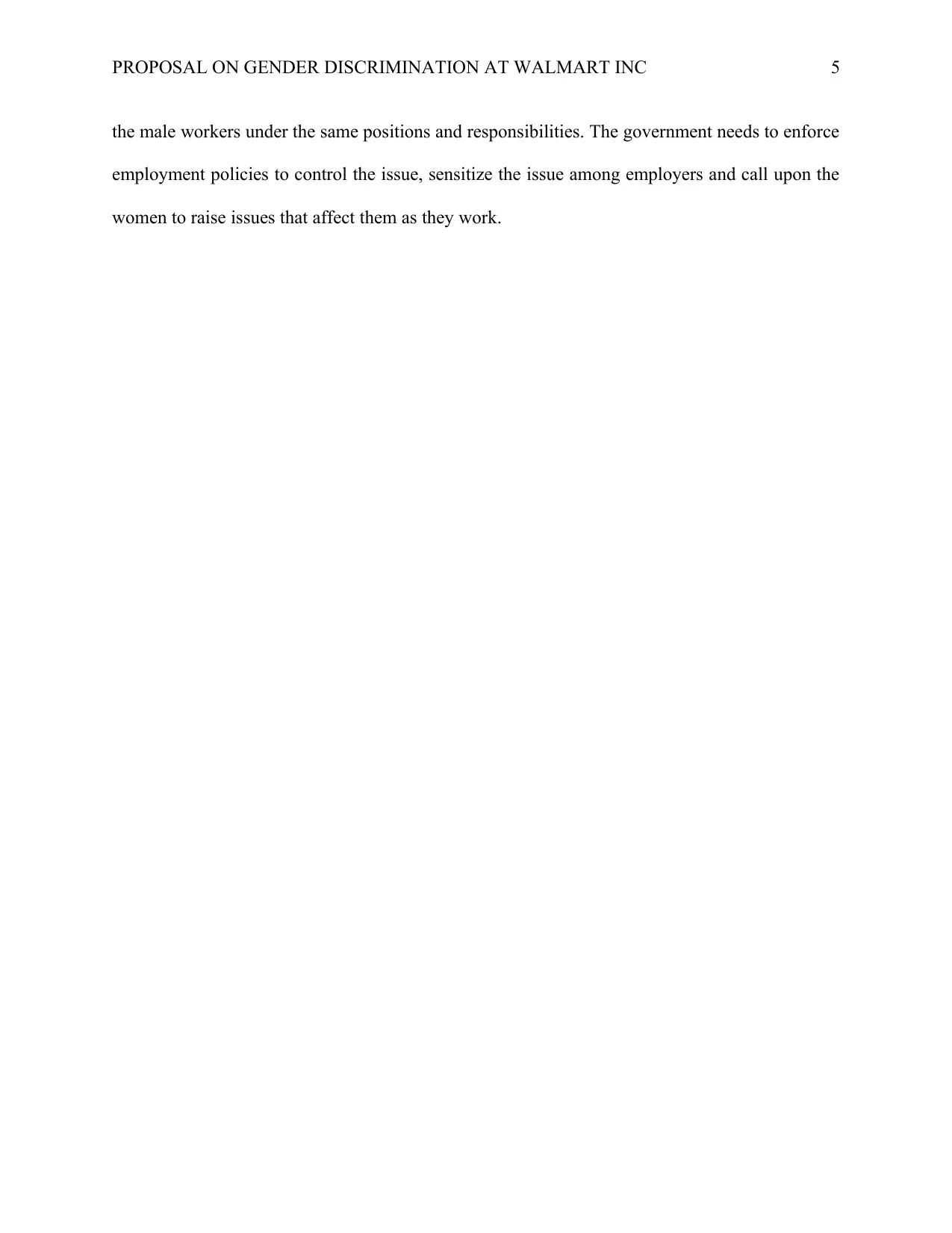
PROPOSAL ON GENDER DISCRIMINATION AT WALMART INC 5
the male workers under the same positions and responsibilities. The government needs to enforce
employment policies to control the issue, sensitize the issue among employers and call upon the
women to raise issues that affect them as they work.
the male workers under the same positions and responsibilities. The government needs to enforce
employment policies to control the issue, sensitize the issue among employers and call upon the
women to raise issues that affect them as they work.
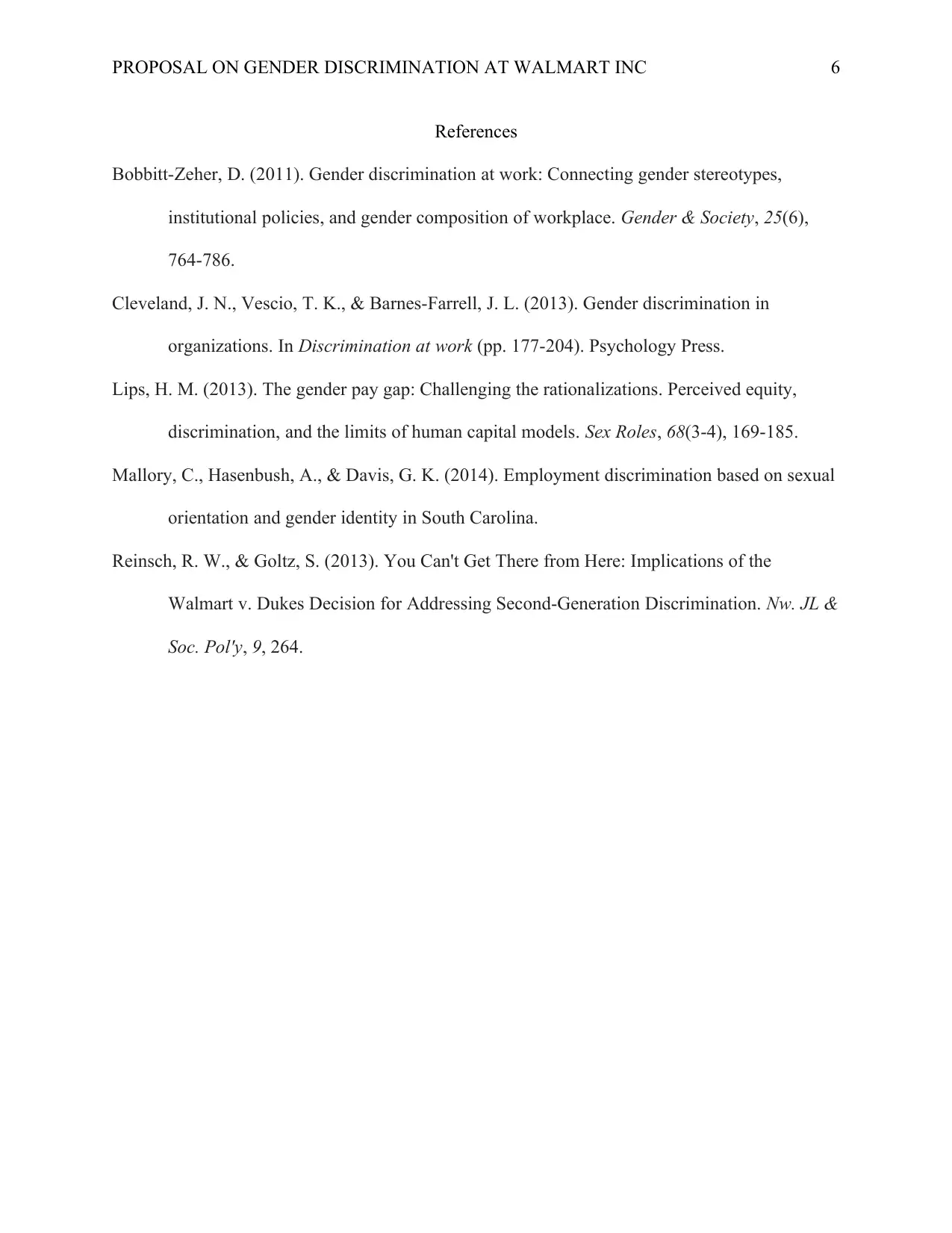
PROPOSAL ON GENDER DISCRIMINATION AT WALMART INC 6
References
Bobbitt-Zeher, D. (2011). Gender discrimination at work: Connecting gender stereotypes,
institutional policies, and gender composition of workplace. Gender & Society, 25(6),
764-786.
Cleveland, J. N., Vescio, T. K., & Barnes-Farrell, J. L. (2013). Gender discrimination in
organizations. In Discrimination at work (pp. 177-204). Psychology Press.
Lips, H. M. (2013). The gender pay gap: Challenging the rationalizations. Perceived equity,
discrimination, and the limits of human capital models. Sex Roles, 68(3-4), 169-185.
Mallory, C., Hasenbush, A., & Davis, G. K. (2014). Employment discrimination based on sexual
orientation and gender identity in South Carolina.
Reinsch, R. W., & Goltz, S. (2013). You Can't Get There from Here: Implications of the
Walmart v. Dukes Decision for Addressing Second-Generation Discrimination. Nw. JL &
Soc. Pol'y, 9, 264.
References
Bobbitt-Zeher, D. (2011). Gender discrimination at work: Connecting gender stereotypes,
institutional policies, and gender composition of workplace. Gender & Society, 25(6),
764-786.
Cleveland, J. N., Vescio, T. K., & Barnes-Farrell, J. L. (2013). Gender discrimination in
organizations. In Discrimination at work (pp. 177-204). Psychology Press.
Lips, H. M. (2013). The gender pay gap: Challenging the rationalizations. Perceived equity,
discrimination, and the limits of human capital models. Sex Roles, 68(3-4), 169-185.
Mallory, C., Hasenbush, A., & Davis, G. K. (2014). Employment discrimination based on sexual
orientation and gender identity in South Carolina.
Reinsch, R. W., & Goltz, S. (2013). You Can't Get There from Here: Implications of the
Walmart v. Dukes Decision for Addressing Second-Generation Discrimination. Nw. JL &
Soc. Pol'y, 9, 264.
⊘ This is a preview!⊘
Do you want full access?
Subscribe today to unlock all pages.

Trusted by 1+ million students worldwide
1 out of 6
Related Documents
Your All-in-One AI-Powered Toolkit for Academic Success.
+13062052269
info@desklib.com
Available 24*7 on WhatsApp / Email
![[object Object]](/_next/static/media/star-bottom.7253800d.svg)
Unlock your academic potential
Copyright © 2020–2025 A2Z Services. All Rights Reserved. Developed and managed by ZUCOL.





